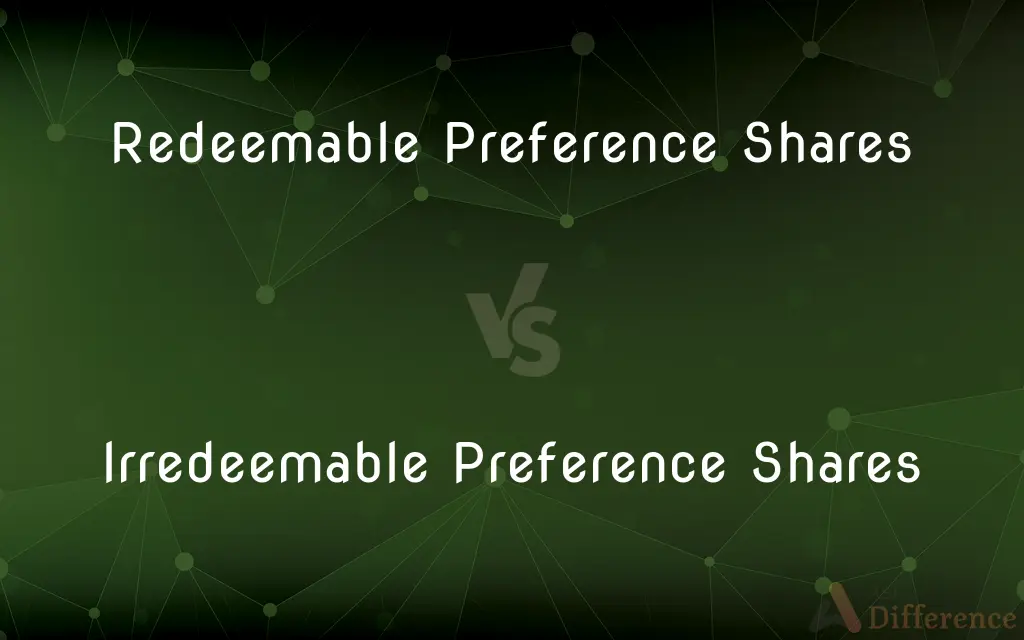Redeemable Preference Shares vs. Irredeemable Preference Shares — What's the Difference?
Edited by Tayyaba Rehman — By Fiza Rafique — Published on December 20, 2023
Redeemable Preference Shares can be bought back by the company, while Irredeemable Preference Shares can't be repurchased.

Difference Between Redeemable Preference Shares and Irredeemable Preference Shares
Table of Contents
ADVERTISEMENT
Key Differences
Redeemable Preference Shares are a type of equity security that a company can repurchase after a specified period. Irredeemable Preference Shares, conversely, remain with the shareholders indefinitely as they can't be repurchased.
The issuer of Redeemable Preference Shares commits to buying back these shares either after a predetermined date or upon the occurrence of specific events. Irredeemable Preference Shares, on the other hand, do not carry any such commitment, making them perpetual in nature.
Companies issuing Redeemable Preference Shares need to set aside funds for their eventual redemption. With Irredeemable Preference Shares, there is no such obligation, as these shares remain outstanding indefinitely.
Redeemable Preference Shares offer companies flexibility in capital structure management. Irredeemable Preference Shares, by contrast, represent a permanent equity base without the option of reducing it through redemption.
Investors in Redeemable Preference Shares know that they can get their principal amount back from the company. Those investing in Irredeemable Preference Shares rely on the market to sell their shares, as the issuing company won't buy them back.
ADVERTISEMENT
Comparison Chart
Buyback Option
Can be repurchased by the company
Cannot be repurchased by the company
Duration
Have a specific maturity or redemption date
Perpetual; no maturity or redemption date
Company Obligation
Must set aside funds for redemption
No obligation to repurchase
Capital Structure
Offers flexibility in capital structure management
Represents a permanent equity base
Investor Assurance
Investors can expect the company to return the principal
Investors rely on the market to sell their shares
Compare with Definitions
Redeemable Preference Shares
Shares with a predetermined redemption date.
Redeemable Preference Shares provide an exit strategy for investors after five years.
Irredeemable Preference Shares
Equity shares that can't be bought back by the company.
The firm's Irredeemable Preference Shares remained outstanding for decades.
Redeemable Preference Shares
Require a company to set aside redemption funds.
The finance team allocated funds for the upcoming redemption of Redeemable Preference Shares.
Irredeemable Preference Shares
Represent a permanent equity commitment.
The company's capital structure was solidified with the issue of Irredeemable Preference Shares.
Redeemable Preference Shares
Provide a buyback assurance to investors.
Knowing the company would repurchase, he invested in Redeemable Preference Shares.
Irredeemable Preference Shares
Require investors to rely on market dynamics for selling.
She decided to sell her Irredeemable Preference Shares on the open market.
Redeemable Preference Shares
Equity shares that a company can buy back.
The corporation issued Redeemable Preference Shares with a 10-year maturity.
Irredeemable Preference Shares
Shares without a specified redemption date.
Investors in Irredeemable Preference Shares knew there wasn't a set exit date.
Redeemable Preference Shares
Offer flexibility in capital management.
To adjust its equity base, the firm considered redeeming some Redeemable Preference Shares.
Irredeemable Preference Shares
Don't obligate companies to repurchase.
Without the need to buy back, the firm issued more Irredeemable Preference Shares.
Common Curiosities
How long do Irredeemable Preference Shares last?
Irredeemable Preference Shares are perpetual, meaning they have no specified end or redemption date.
Do Redeemable Preference Shares have a maturity date?
Yes, Redeemable Preference Shares have a predetermined redemption or maturity date.
Do companies need to set funds aside for Irredeemable Preference Shares?
No, companies don't need to set funds aside for repurchasing Irredeemable Preference Shares as they are not repurchased.
What are Redeemable Preference Shares?
Redeemable Preference Shares are equity shares that a company can buy back after a specified period.
What makes Irredeemable Preference Shares different?
Irredeemable Preference Shares can't be repurchased by the company, making them perpetual.
Why might a company issue Redeemable Preference Shares?
Companies might issue Redeemable Preference Shares to maintain flexibility in their capital structure.
Are Irredeemable Preference Shares common?
Their prevalence varies by jurisdiction and market condition. Some countries and companies prefer them for their permanence.
Do Redeemable Preference Shares pay dividends?
Yes, like other preference shares, they typically pay dividends before common shares.
Can I sell my Redeemable Preference Shares before the redemption date?
Yes, you can sell them on the open market, if there's a market for those shares.
Is the dividend rate fixed for Irredeemable Preference Shares?
Typically, yes. Irredeemable Preference Shares often have a fixed dividend rate.
Is it easier to sell Redeemable or Irredeemable Preference Shares?
It depends on market conditions and investor preferences. Some may prefer the redemption feature of Redeemable ones.
Can a company decide to redeem Irredeemable Preference Shares?
No, by definition, Irredeemable Preference Shares cannot be repurchased by the issuing company.
What happens if a company can't redeem its Redeemable Preference Shares?
It may face legal consequences and reputational damage, as it's an obligation.
Which type of shares has a higher priority in receiving dividends?
Both Redeemable and Irredeemable Preference Shares typically have a higher priority than common shares in receiving dividends.
Are there any risks associated with investing in Irredeemable Preference Shares?
Yes, they include market liquidity risks and the perpetual nature of the investment without a guaranteed company buyback.
Share Your Discovery

Previous Comparison
Maestro Card vs. MasterCard
Next Comparison
PPM vs. PPMVAuthor Spotlight
Written by
Fiza RafiqueFiza Rafique is a skilled content writer at AskDifference.com, where she meticulously refines and enhances written pieces. Drawing from her vast editorial expertise, Fiza ensures clarity, accuracy, and precision in every article. Passionate about language, she continually seeks to elevate the quality of content for readers worldwide.
Edited by
Tayyaba RehmanTayyaba Rehman is a distinguished writer, currently serving as a primary contributor to askdifference.com. As a researcher in semantics and etymology, Tayyaba's passion for the complexity of languages and their distinctions has found a perfect home on the platform. Tayyaba delves into the intricacies of language, distinguishing between commonly confused words and phrases, thereby providing clarity for readers worldwide.











































